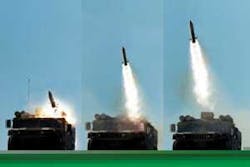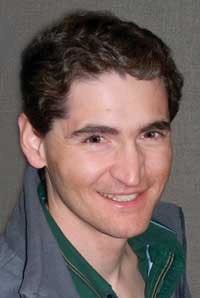High-speed recording boosts image capture and processing
A discussion with Carlos Jorquera of Boulder Imaging
VSD: What applications or industries does Boulder Imaging serve and with what technologies?
Jorquera: We offer two main product lines: high-performance digital video recording (DVR) systems and several levels of defect-inspection solutions. Our VisionRecorder line of DVRs ranges from entry level, which is compact and can record from one camera input for a couple of hours at a data rate of up to 40 Mbytes/s, to our ultrahigh level, which can record from up to 24 camera inputs for more than 24 hours at data rates exceeding 500 Mbytes/s. Any number of our higher-level systems can operate in unison and provide virtually unlimited capacity for video input and recording duration.
Our VisionNow software manages all the data flow through the DVR system, as well as providing a GUI for controlling recording options, video playback, postprocessing, and image analysis. VisionNow is founded on a component-based architecture that is hardware-independent, allowing support for any video input.
Defect-inspection solutions range from cost-effective “vision appliances,” which inspect electronic and mechanical parts for defects in fabrication or labeling, to custom-built inspection systems suitable for high-throughput, fully automated production plants. The vision appliances are built by ipd (Billerica, MA, USA; www.goipd.com) and can inspect for a multitude of common fabrication problems including missing or incorrect components on an electronic board, patterns and shapes in metals or plastics that don’t match predetermined sizing and positioning criteria, and misaligned or damaged labels in foods or pharmaceutical containers.
Our custom-built inspection systems are specialized for detecting surface flaws in parts and materials that must be built with a high degree of uniformity. The systems can detect flaws as small as 10 µm in products such as laser printer drums, optical coatings, plastics, papers, and textiles. These inspection systems are built for real-time response and can be integrated into the production line using new or existing robotic and automation hardware.
Our customers include universities, government labs, military test ranges, industrial production plants, medical imaging companies, and just about any entity that needs to record multiple, simultaneous video sources for process control, event monitoring, or surveillance.
VSD: What market changes are driving the implementation of these technologies?
Jorquera: More and more industries are seeing the benefits of imaging and vision in improving their production efficiency and product quality. These technologies are no longer limited to the larger companies or, for that matter, to companies with a dedicated engineering staff. For this trend to continue, we need to focus on improving the human interface that our systems implement so that it becomes intuitive and efficient for someone without any imaging experience to operate.
For our VisionRecorder systems, we see a continuously increasing need for higher and higher data rates, driven by the desire for higher-resolution imagery, faster-frame-rate video, and larger numbers of cameras that need to be simultaneously recording. These ever-increasing demands motivate us to seek hardware platforms with the best upgrade paths possible, as well as to continuously strive for software that is hardware-independent and highly scalable. In addition, a direct result of these higher data rates is the growing challenge of how to manage the vast amounts of video data that are being collected, in terms of analysis, archiving, and efficient retrieval.
VSD: Where are you seeing the most growth? What are users demanding from you in the design of new systems?
Jorquera: One area in which we expect to experience significant growth is intelligent surveillance. Currently most surveillance applications simply record video, hoping to capture an event of interest such as theft of merchandise from a department store. Later, an operator has the grueling task of reviewing endless hours of video looking for suspicious events. Intelligent surveillance systems aim to detect the suspicious event as it’s happening, possibly alerting someone, or at worst, flagging the period of video as suspicious and needing prompt human review.
Boulder Imaging digital-video-recording system, provided to Lockheed Martin, tests the US Army Line-of-Sight Antitank Weapon System missile. The camera system, stationed on top of a Hummer, captured 250 Mbytes/s of visual information.
One fairly common request for our newer systems is for more redundancy to reduce downtime as well as to reduce the risk of losing data. Many of our customers use our systems around the clock as a critical part of their production process-therefore they need to have minimal downtime. We can satisfy this need by providing systems with more redundant components, as well as modular components that can be quickly replaced. For our customers who place a much greater value on the actual data that they record, we now offer redundant disk arrays that can tolerate complete malfunction of one or more data disks.
VSD: What technologies and components does Boulder Imaging use in these applications?
Jorquera: Since the architecture of our systems is hardware-independent, we can support just about any camera or frame grabber. For every solution that we build, however, we choose the best camera that will match application requirements such as sensitivity, resolution, dynamic range, speed, and spectral response.
For analog camera solutions we tend to use cameras from Hitachi (Wadsworth, OH, USA; www.hdal.com), JAI Pulnix (Sunnyvale, CA, USA; www.jaipulnix.com), and Teli (Irvine, CA, USA; www.toshiba-teli.co.jp). For digital cameras we generally use Basler (Ahrensburg, Germany; www.baslerweb.com), Cooke (Romulus, MI, USA; www.cookecorp.com), Cohu (San Diego, CA, USA; www.cohu-cameras.com), Dalsa (Waterloo, ON, Canada; www.dalsa.com), Hitachi, JAI Pulnix, Teli, and Uniq Vision (Santa Clara, CA, USA; www.uniqvision.com).
For infrared cameras we generally use FLIR (North Billerica, MA, USA; www.flirthermography.com), Santa Barbara Focalplane (Goleta, CA, USA; www.sbfp.com), and Sensors Unlimited (Princeton, NJ, USA; www.sensorsinc.com). And for frame grabbers we currently have support for most analog and digital models offered by Bitflow (Woburn, MA, USA; www.bitflow.com), Coreco (St.-Laurent, QC, Canada; www.imaging.com), Datacube (Danvers, MA, USA; www.datacube.com), Epix (Buffalo Grove, IL, USA; www.epixinc.com), Euresys (Angleur, Belgium; www.euresys.com), Great River (Albuquerque, NM, USA; www.greatrivertech.com), Leutron (Glattbrugg, Switzerland; www.leutron.com), and Wintress (San Diego, CA, USA; www.weco.com).
VSD: How do you approach a new application?
Jorquera: We qualify every application to make sure that it’s a good match for the technology that we offer, which we design and build ourselves. We do this by becoming intimately familiar with the customer’s requirements and by trying to understand the ultimate goals that the customer wants to achieve with our system.
It is also very important to be aware of all the use cases, as well as all the operating conditions to which the system will be submitted, such as exposure to humidity, temperature variations, vibration, shock, and high altitudes. Once we have all this information we can proceed to assess whether or not our technology can satisfy all the customer’s needs.
VSD: Do you perform your own system integration or look outside for support?
Jorquera: We do all system integration in-house, except for the occasions when we are subcontracted by another system integrator that wants to make use of our specific technology and expertise.
VSD: What kinds of new applications do you expect to emerge?
Jorquera: We expect the combined data rates generated by imaging sources to increase dramatically. Fortunately, data-storage technology is also expected to improve dramatically, with the prospect of holographic storage devices not too far in the future. Processing power is also on track to make profound improvements, allowing for far more sophisticated video-understanding algorithms to be implemented than are possible today. This would allow vision systems to identify actions and events in video as they are taking place, which could be beneficial for crime prevention and security applications, as well as for data-mining of video archives.
VSD: How should OEM machine-vision components change to meet emerging uses?
Jorquera: Improved interoperability between components through standardization of interfaces would greatly reduce the time it takes to integrate a sophisticated imaging and machine-vision system. The Camera Link standard has gone a long way to speed up the process of interfacing to new cameras. Similar standardization of software interfaces to image-capture hardware could prove beneficial.
CARLOS JORQUERA is president and senior systems engineer, Boulder Imaging (Louisville, CO, USA; www.boulderimaging.com), which he founded in 1995 as CJ Computational Systems. He has a B.S. in physics and electrical engineering from the Massachusetts Institute of Technology and previously worked on imaging systems for spacecraft and ground-based telescopes at the NASA Jet Propulsion Laboratory. Editor in chief Conard Holton talked to him about bridging the gap between high-performance cameras and image-processing software.


